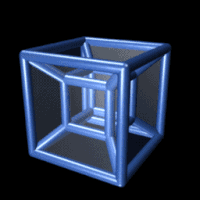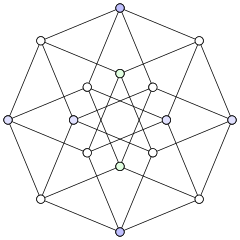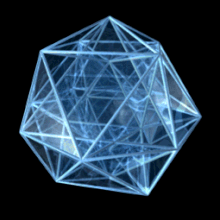| Revision as of 19:59, 6 March 2008 edit82.134.121.18 (talk)No edit summary← Previous edit | Revision as of 01:39, 7 March 2008 edit undoXnuala (talk | contribs)7,020 edits Clarifying some languageNext edit → | ||
| Line 9: | Line 9: | ||
| If time is considered as the "fourth dimension", the additional fourth spatial dimension would be referred to as the ]. Alternatively, time can be considered as the 0th dimension, and all positive-numbered dimensions spatial. | If time is considered as the "fourth dimension", the additional fourth spatial dimension would be referred to as the ]. Alternatively, time can be considered as the 0th dimension, and all positive-numbered dimensions spatial. | ||
| Another ] dimension ] to the other three spatial dimensions has been discussed. The cardinal directions in the three known dimensions may be referred to as up/down (altitude), north/south (latitude), and east/west (longitude). When speaking of the fourth spatial dimension, an additional pair of terms is needed. Attested terms include ]/] (sometimes called ] or spassitude), vinn/vout (used by ]), and upsilon/delta. | |||
| {| style="margin: 0 auto;" | {| style="margin: 0 auto;" | ||
Revision as of 01:39, 7 March 2008
| This article does not cite any sources. Please help improve this article by adding citations to reliable sources. Unsourced material may be challenged and removed. Find sources: "Four-dimensional space" – news · newspapers · books · scholar · JSTOR (June 2007) (Learn how and when to remove this message) |

There are three conventional spatial dimensions: length (or depth), width, and height, often expressed as 'x', 'y' and 'z'. 'x' and 'y' axes appear on a plane Cartesian graph. In the 3rd dimension, a 'z' is used and is found in functions such as a "z-buffer" in computer graphics, for processing "depth" in imagery. The fourth dimension is often identified with time in physics, and as such is used to explain the non-Euclidean space-time used in Einstein's theories of special relativity and general relativity.
When a reference is used to four-dimensional coordinates, it is likely that what is referred to is the three spatial dimensions plus a time-line. If 4 (or more) spatial dimensions are referred to, this should be stated at the outset, to avoid confusion with the more common notion that time is the Einsteinian fourth dimension.
If time is considered as the "fourth dimension", the additional fourth spatial dimension would be referred to as the fifth dimension. Alternatively, time can be considered as the 0th dimension, and all positive-numbered dimensions spatial.
Another spatial dimension orthogonal to the other three spatial dimensions has been discussed. The cardinal directions in the three known dimensions may be referred to as up/down (altitude), north/south (latitude), and east/west (longitude). When speaking of the fourth spatial dimension, an additional pair of terms is needed. Attested terms include ana/kata (sometimes called spissitude or spassitude), vinn/vout (used by Rudy Rucker), and upsilon/delta.
 |
 |

|
Concepts
The fourth spatial dimension and orthogonality
A right angle is defined as one quarter of a revolution and "orthogonal" (from the Greek) refers to coordinates or functions that are at right angles to each other. Cartesian geometry arbitrarily chooses orthogonal directions through space, which means that they add height. The fourth dimension is therefore the direction in space that is at right angles to these three observable directions.
Vectors

The fourth spatial dimension can be thought of in terms of vectors, analogous to arrows, fixed from some single place in space which we call the origin, that point to other places. These are called geometric vectors.
A point is a zero-dimensional object. It has no extension in space, and no properties. If one were to think of this point as a geometric vector, like an arrow, it would have no length. This vector is called the zero vector.
A line is a one-dimensional object. If we pick some nonzero vector in some direction, this vector has some definite length. That vector has a head at some point in space and a tail at the origin. If we think of stretching that vector so it is twice as long, three times as long, and so on and even stretching it backwards so it takes all possible lengths it can (even zero length, to get the zero vector), we get a single line with one dimension of length. All the vectors that describe points on this line are said to be parallel to each other. Even though any line we can draw must have some small thickness (so that we can see it), this theoretical line does not.
A plane is a two-dimensional object. It has a finite length and breadth but no thickness — somewhat like a sheet of paper (but paper too has some thickness). Thinking of a plane in terms of vectors can be a little more challenging. If we think of taking one vector and moving it so that its tail is touching the head of the first and forming a vector with its tail at the origin and the head at the head of the repositioned second vector, we have a reasonable way of talking about adding vectors. If we have two vectors that are not parallel, we can talk about all the points we can reach by stretching either of the vectors (or not stretching them), and, adding these vectors together, these points form a plane. We say that the two vectors span the plane.
Space, as we perceive it, is three-dimensional. We can think of putting a line together with a "stack" of planes. These planes are "stuck together" like a sandwich, with the line passing through them like a skewer. To get to some point in space, we can imagine traveling up the line and then moving across the plane to the point. We then have three vectors to think about, one to travel some distance up the line and two to get to some point in space.
The fourth spatial dimension, then, can be described by "sticking together", that is by attaching or merging, several three-dimensional spaces in a row, but in a way that extends into the fourth dimension. To understand this concept, think of putting pieces of paper side by side. The sheets do not extend into the third dimension until one puts them on top of one another (to add height, along with the other two dimensions). So in order to extend into the fourth dimension, it is necessary to add "ana" or "kata." To get to some point in the four-dimensional space, one travels along the three-dimensional spaces, and also across the fourth dimension. The total number of vectors involved is four.
Mathematically, the 4-dimensional spatial equivalent of conventional 3-dimensional geometry is the Euclidean 4-space, a 4-dimensional normed vector space with the Euclidean norm. The "length" of a vector
expressed in the standard basis is given by
which is the natural generalisation of the Pythagorean Theorem to 4 dimensions. This allows for the definition of the angle between two vectors (see Euclidean space for more information).
Geometry with four spatial dimensions

In four spatial dimensions, Euclidean geometry provides for a greater variety of shapes to exist than in three dimensions. Just as three-dimensional polyhedrons are spatial enclosures made out of connected two-dimensional faces, the four-dimensional polychorons are enclosures of four-dimensional space made out of three-dimensional cells. Where in three dimensions there are exactly five regular polyhedrons, or Platonic solids, that can exist, six regular polychorons exist in four dimensions. Five of the six can be interpreted as natural extensions of the Platonic solids, just as the cube, itself a Platonic solid, is a natural extension of the two-dimensional square.
The pentachoron is constructed out of 5 tetrahedrons for cells and 10 triangular faces, and is the four-dimensional analogue of the tetrahedron. The tesseract is made out of 8 cubic cells and 24 squares, and is the four-dimensional hypercube. The tesseract's dual, the 16-cell, is the equivalent of the octahedron cross-polytopes.
The 120-cell and 600-cell are duals of each other, and are analogous to the dodecahedron and icosahedron, respectively. The 24-cell is the unique regular polychoron in that it has no three-dimensional equivalent.
There are also a large set of semiregular polychora, called convex uniform polychoron, most of which can be derived from the 6 regular forms above.
Just as the sphere, or 2-sphere, is a curved two-dimensional surface made up of all points equidistant from a given central point in three-dimensional space, the 3-sphere, a kind of hypersphere, is the space containing all points equidistant to a given central point in four-dimensional space. Every three-dimensional cross section of a 3-sphere is a 2-sphere.
Dimensional analogy

To make the leap from three spatial dimensions into four, a device called dimensional analogy is commonly employed. Dimensional analogy is studying how (n – 1) dimensions relate to n dimensions, and then inferring how n dimensions would relate to (n + 1) dimensions.
For example, in the book Flatland, Edwin Abbott Abbott writes about a square that lives in a two-dimensional world, like the surface of a piece of paper. A three-dimensional being has seemingly god-like powers from the perspective of this square: such as being able to remove objects from a safe without breaking it open (by moving them across the third dimension), see everything that from the two-dimensional perspective is enclosed behind walls, and remaining completely invisible by standing a few inches away in the third dimension. By applying dimensional analogy, one can infer that a four-dimensional being would be capable of similar feats from our three-dimensional perspective. Rudy Rucker demonstrates this in his novel Spaceland, in which the protagonist encounters four-dimensional beings who demonstrate such powers.
A useful application of dimensional analogy in visualizing the fourth dimension is in projection. A projection is a way for representing an n-dimensional object in n − 1 dimensions. For instance, computer screens are two-dimensional, and all the photographs of three-dimensional people, places and things are represented in two dimensions by removing information about the third dimension. In this case, depth is removed and replaced with indirect information. The retina of the eye is a two-dimensional array of receptors but it can allow the brain to perceive the nature of three-dimensional objects using indirect information (such as shading, foreshortening, binocular vision etc.). Artists use perspective to give three-dimensional depth to two-dimensional pictures.
Similarly, objects in the fourth dimension can be mathematically projected to the familiar 3 dimensions, where they can then be more conveniently examined. In this case, the 'retina' of the four-dimensional eye is a three-dimensional array of receptors. A hypothetical being with such an eye would perceive the nature of four-dimensional objects using indirect information contained in the images it receives in its retina. Perspective projection from four dimensions produces similar effects as in the three-dimensional case, such as foreshortening. This adds four-dimensional depth (depth, of course, being technically incorrect, but no proper word comes to mind) to these three-dimensional pictures.
Dimensional analogy also helps in understanding such projections. For example, two-dimensional objects are bounded by one-dimensional boundaries: a square is bounded by four edges. Three-dimensional objects are bounded by two-dimensional surfaces: a cube is bounded by 6 squares. By applying dimensional analogy, one may infer that a four-dimensional cube, known as a tesseract, is bounded by three-dimensional volumes. And indeed, this is the case mathematically: the tesseract is bounded by 8 cubes. Knowing this is key to understanding how to interpret a three-dimensional projection of the tesseract. The boundaries of the tesseract project to volumes in the image, not merely two-dimensional surfaces. This helps in understanding features of such projections that may otherwise be very puzzling.
Likewise the concept of shadows can help us better understand the theory of four dimensions. If you were to shine a light on a three dimensional object, it would cast a two dimensional shadow. Therefore light on a two-dimensional object would cast a one-dimensional shadow (in a two-dimensional world), and light on a one-dimensional object in a one-dimensional world would cast a zero-dimensional shadow, that is, a point of non-light. This idea can be used in the other direction; light on a four-dimensional object would cast a three-dimensional shadow.
As an example of this, imagine that light is shone down through a wireframe cube onto a flat surface. The shadow that results is that of a square within a square with each of the corners connected. Similarly, if a four-dimensional cube were lit "from above", its shadow would be that of a three-dimensional cube within another three-dimensional cube.
Being three-dimensional we are only able to see the world with our eyes in two dimensions; a four-dimensional being would see the world in three. Thus it would be able, for example, to see all six sides of an opaque box simultaneously. Not only so; it would also be able to see what was inside the box at the same time, just like in Flatland, where the sphere sees objects in the two-dimensional world and everything inside them simultaneously. Analogously, a four-dimensional viewer would see all points in our 3-dimensional space simultaneously, including the inner structure of solid objects and things obscured from our three-dimensional viewpoint.
The dimensions can be determined by counting the basic line patterns on the object. 1 Dimension will only have 1 basic line, 2 dimensions will have 2 (appearing as a right angle), 3 dimensions will appear as the "corner" trick, or a peace sign. 4 dimensions can be represented with an X. The sides of the X are still intact, but our brain will not comprehend the fact that opposite sides of the X are still perpendicular, not collinear.
Reasoning by analogy from familiar lower dimensions can be an excellent intuitive guide, but care must be exercised not to accept results that are not more rigorously tested. For example, consider the formulas for the circumference of a circle and the surface area of a sphere: . One might be tempted to suppose that the surface volume of a hypersphere is , or perhaps , but either of these would be wrong. The correct formula is .
See also
- Euclidean space
- Euclidean geometry
- 4-manifold
- Exotic R
- First dimension
- Second dimension
- Third dimension
- Fifth dimension
- 3-sphere
- List of geometry topics
- Block Theory of the Universe
- Flatland Book written by Edwin A. Abbott about two and three-dimensional space, to understand the concept of four dimensions
- Sphereland Unofficial Sequel to Flatland
- 4D Man. 1959 Sci-Fi horror film.
External links
- Garrett Jones' tetraspace page
- Flatland: a Romance of Many Dimensions
- 4D visualization
- TeV scale gravity, mirror universe, and ... dinosaurs Article from Acta Physica Polonica B by Z.K. Silagadze.
- Exploring Hyperspace with the Geometric Product
- 4D
- 4D Building Blocks - Interactive game to explore 4D space
| Time | |||||||||
|---|---|---|---|---|---|---|---|---|---|
| Key concepts | |||||||||
| Measurement and standards |
| ||||||||
| Philosophy of time | |||||||||
| Human experience and use of time | |||||||||
| Time in science |
| ||||||||
| Related | |||||||||


 and the surface area of a sphere:
and the surface area of a sphere:
 .
One might be tempted to suppose that the surface volume of a hypersphere is
.
One might be tempted to suppose that the surface volume of a hypersphere is  , or perhaps
, or perhaps  , but either of these would be wrong. The correct formula is
, but either of these would be wrong. The correct formula is  .
.